When you’re moving home or doing some DIY in your house, those big items of furniture can get in the way. Putting your bulky items can open up your space whilst protecting them from damage. It can seem daunting when you consider all the pieces that you want to pack away and knowing the best way to protect them whilst in long-term storage is difficult. But don’t be put off! We’ve put together some simple tips on storing those larger items around your home, from preparing them beforehand to arranging your storage.
Finding the perfect place
The perfect place to store your items depends entirely on you and your preferences. If you have an attic space or garage in which your items would be safe, this can be a great and cheap way to make more space in your home. However, it’s important that you check out these areas beforehand: Leaks, damp and cold temperatures can cause permanent damage to your belongings. It will also make access to these areas more difficult, so think carefully about how long the large items will need to stay there and if you are prepared for this inconvenience. Moving your items upstairs or through doors might also cause damage to the furniture or your walls and doorways, so it might be easier to choose to store them externally.
Storage units can be a great place to store your bulky furniture. Read our blog to read about the differences between self-storage and storage warehouses. They are secure, flexible and are available in a variety of sizes to suit your needs. Facilities at the storage site can also help in moving your belongings safely and protecting them from damage whilst in storage.
Clean
Before your items go into storage, they might need a little attention. From day-to-day use, it is natural that your furniture gets a little dirty and worn. This is no problem when it’s in constant use, however, in long-term storage this can become a problem. As dirt sits on fabrics or wood for prolonged periods, it can permanently damage your items. This can be prevented with a clean before storage. What you will need to do depends, of course, on the type of material that the furniture consists of. For example, leather chairs and sofas may just require a wipe-down, while you may want to wax or varnish your wooden items to preserve them.
Disassemble
We recommend taking apart your items as much as possible before they go into your storage location. This includes not just removing table and chair legs where applicable but also removing sofa and armchair cushions. Packing all the parts separately will make your items easier to transport and also prevent damage caused by parts knocking against one another or being broken under any weight from other objects. Make sure to keep any screws or bolts safe for when you reassemble!
Protect
After disassembling your furniture, now is the time to cover them. For smaller and more delicate objects, such as lamps or stools, bubble wrap or similar material can protect them from little knocks and bumps. For your bulky furniture, bubble wrap might not be an option. Furniture covers can be great to keep dust and dirt off of your items if they are in prolonged storage, but you can also use old towels or bed sheets for the same effect.
You can buy professional grade boxes from any of our branches, or via our box shop.
Check space
In the interest of preserving your furniture items, scoping out your storage space is a great idea. You should be checking the floor, walls, and ceilings for any damp or leaks. If the floor is particularly rough, it could be a good idea to cover areas where large items will be standing.
Have a plan
When packing your storage space, you should have this planned before you start moving in. Whilst it can seem obvious, it may end up more complicated than you first expected. Think about all the items that could go into storage and plan which items can be stacked and which can’t. This will depend on the structure and material of the items: For example, leather couches could be damaged by bulky shelving units being placed on top. It’s also a good idea to place your biggest items at the back of the space, vertically if possible, to save space and allow access to the rest of the area.
If you are ready to start the storage process, learn more about storage solutions with Bishop’s Move.

FIND YOUR BISHOP'S MOVE



 Previous story
Previous story